
Marble floors add elegance and sophistication to any bathroom. However, to maintain their beauty and preserve their luster, proper cleaning and maintenance are essential. Marble is a delicate material that requires specific care to prevent damage and staining. In this comprehensive guide, we will explore effective methods and techniques for cleaning marble floors in bathrooms.
Why Clean Marble Floors Regularly?
Marble floors are susceptible to dirt, grime, and stains due to their porous nature. Regular cleaning helps prevent the buildup of debris and maintains the natural shine of the marble surface. Additionally, cleaning removes bacteria and germs, promoting a hygienic environment in your bathroom.
Tools and Materials Needed
Before you begin cleaning your marble floors, gather the following tools and materials:
- Soft-bristled broom or vacuum cleaner
- pH-neutral marble cleaner
- Microfiber mop or soft cloth
- Warm water
- Bucket
- Mild dish soap (optional)
- Soft towels or cloths for drying
Step-by-Step Cleaning Process
Follow these steps to effectively clean marble floors in your bathroom:
- Remove Surface Debris: Begin by sweeping or vacuuming the marble floor to remove any loose dirt, dust, or debris. Use a soft-bristled broom or a vacuum cleaner with a brush attachment to avoid scratching the marble surface.
- Prepare Cleaning Solution: Fill a bucket with warm water and add a small amount of pH-neutral marble cleaner. Avoid using acidic or abrasive cleaners, as they can damage the marble. Alternatively, you can mix warm water with a few drops of mild dish soap.
- Dampen Mop or Cloth: Dip a microfiber mop or a soft cloth into the cleaning solution. Wring out excess liquid to prevent oversaturation.
- Clean the Marble Floor: Gently mop or wipe the marble floor with the damp cloth or mop. Work in small sections, focusing on one area at a time. Avoid using excessive force or pressure to prevent scratches.
- Rinse with Clean Water: Once you have cleaned the entire floor, rinse the marble surface with clean water to remove any residue or cleaner buildup. Make sure to change the water in the bucket as needed.
- Dry the Surface: Use soft towels or cloths to dry the marble floor thoroughly. Avoid letting the marble air dry, as water spots may form.
- Polish (Optional): For added shine, you can polish the marble floor using a marble-specific polish or a microfiber cloth. Follow the manufacturer’s instructions for best results.
- Regular Maintenance: To keep your marble floors looking their best, establish a regular cleaning schedule. Sweep or vacuum the floor daily to remove dirt and debris, and perform a deeper cleaning once or twice a week.
FAQs: Frequently Asked Questions
1. Can I use vinegar to clean marble floors?
No, vinegar is acidic and can damage the marble surface. It is best to use a pH-neutral cleaner specifically designed for marble.
2. How do I remove stains from marble floors?
For organic stains, such as coffee or wine, you can create a poultice using baking soda and water. Apply the poultice to the stain, cover it with plastic wrap, and let it sit overnight. Rinse and dry the area thoroughly.
3. Is it necessary to seal marble floors?
Yes, sealing marble floors helps protect them from stains and damage. Apply a quality marble sealer according to the manufacturer’s instructions.
4. Can I use a steam mop on marble floors?
It is not recommended to use a steam mop on marble floors, as the heat and moisture can damage the surface. Stick to gentle cleaning methods with warm water and mild cleaners.
5. How do I prevent scratches on marble floors?
Place felt pads under furniture legs to prevent scratches from moving furniture. Avoid dragging heavy objects across the marble surface.
6. What should I do if my marble floor has etch marks?
Etch marks are dull spots caused by acidic substances. You can buff out minor etch marks using a marble polishing powder and a soft cloth.
7. Can I use bleach to clean marble floors?
No, bleach is too harsh for marble and can cause discoloration and damage. Stick to gentle, pH-neutral cleaners.
8. How often should I reseal my marble floors?
Marble floors should be resealed every 6 to 12 months, depending on usage and wear. Perform a water test to determine if the sealer is still effective.
9. What should I do if my marble floor is cracked or chipped?
For minor cracks or chips, you can fill them in with a color-matched epoxy resin. For extensive damage, consult a professional marble restoration expert.
10. Can I use abrasive scrubbing pads on marble floors?
No, abrasive scrubbing pads can scratch the marble surface. Stick to soft cloths or microfiber mops for cleaning.
Conclusion
Cleaning marble floors in bathrooms requires gentle care and attention to detail. By following the proper cleaning methods and using the right tools and materials, you can maintain the beauty and durability of your marble floors for years to come. Remember to avoid harsh chemicals and abrasive cleaners, and always test any new cleaning products in a small, inconspicuous area before use. With regular maintenance and proper care, your marble floors will continue to be a stunning focal point in your bathroom space.
